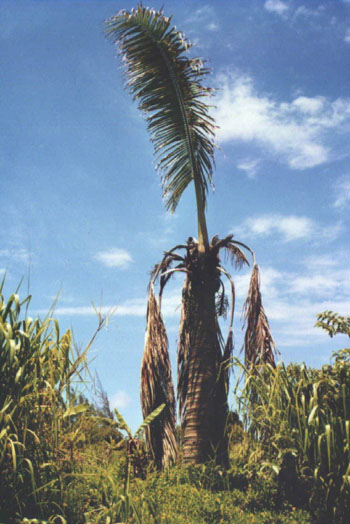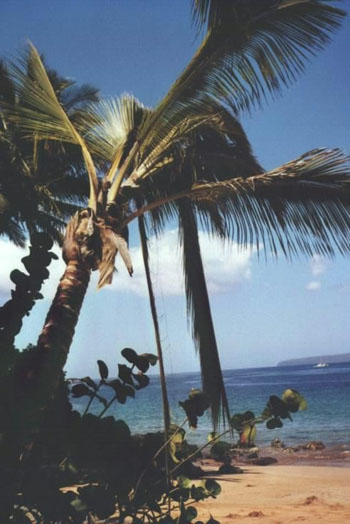Rotten at the Core pg.3

Final Stages

Makena
Because coconut trees are very slow growing (about one foot per year), it is estimated that a highly prized 20 foot tree is about 20 years old. At $50 per foot of trunk, plus transportation, equipment (e.g., backhoe, crane), and labor charges, the cost to remove and replace a dead tree with another of similar stature could be as much as $3,000 or more. In some situations, accessibility may be a problem and replacing it may be impractical. For some businesses, it may create a huge disturbance to its customers and guests. Furthermore, trees of this size are in short supply or may be unavailable from many nurseries.
Preliminary research conducted on Kaua`i by the university showed that disease protection was being achieved by injection into the trunk of coconut trees. Unfortunately, this experiment was destroyed by Hurricane Iniki before the final results could be taken. In an effort to save Hawai`i’s coconut trees, the Hawai`i Farm Bureau Federation, Department of Agriculture, University of Hawai`i, Maui Association of Landscape Professionals, Hawai`i Organic Farmers Association, several Hotel Associations, and the County of Maui are supporting a funding request to the State Legislature to enable UH to finalize its research on this disease.
In the meantime, an education and injection program has been put together by Hawai`i Coconut Protectors to help protect the palms from contracting the disease. Seminars, Presentations to both the Landscaping and Tourism Industry have been held. Many private owners, hotels and resorts, golf courses, restaurants, condos have already protected their trees. The collaboration and support of residents is needed to stop the further spread of the disease. Because of the large population of coconut palms, as well as the fact that they do not show any outside noticeable symptoms until they are dead and usually cut down, the disease has been allowed to spread and remain unnoticed to the untrained eye. The reality is that we are starting to see landscaping like that of the picture on top, taken on the windward side of Maui. If we wait any longer, we will not be able to save our island heritage.
